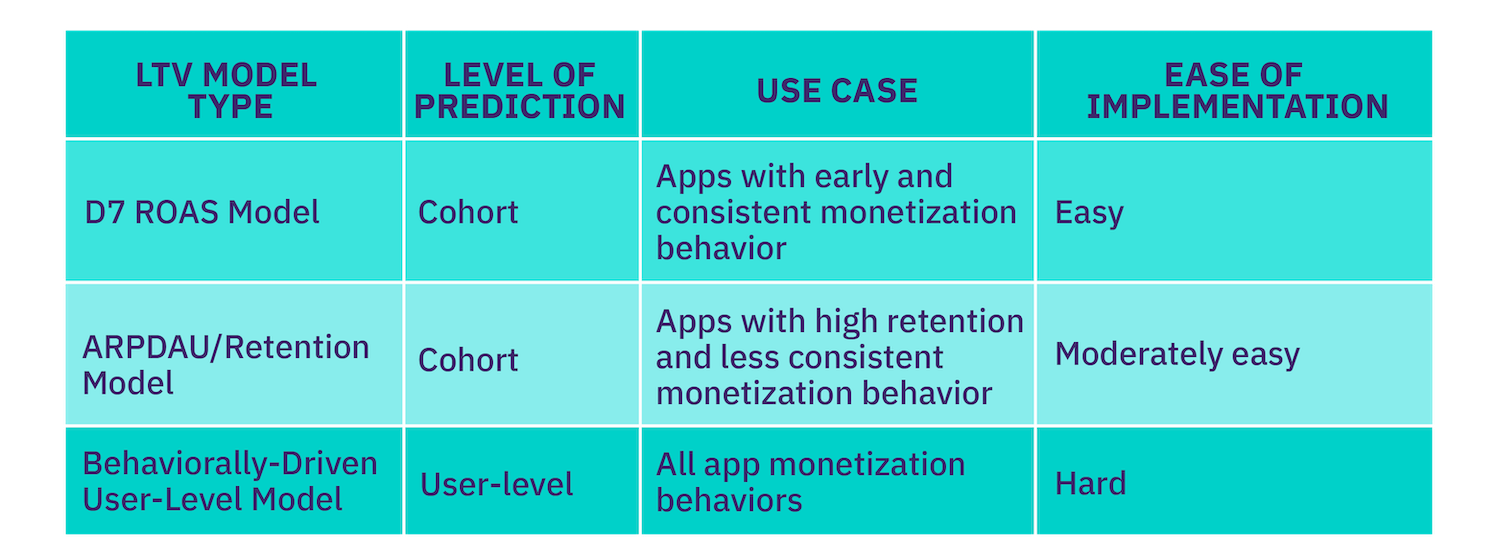
The Future of UA: Where Does LTV Modeling Go From Here?
In the “The Future of UA” series for the Vungle blog, we unpack key trends or issues confronting mobile marketers in the ever-evolving mobile industry. Second up in the series: LTV. Where does it go from here?
As Apple, Google, and others continue to usher in a more privacy-conscious mobile marketing landscape, many industry pundits prophesied that LTV modeling will see the same fate as user-level attribution—an inevitable death.
These prophecies couldn’t be further from the truth.
In this second part of “The Future of UA” series, we unpack why an LTV model for mobile app marketing is as important as ever.

In All (LTV) Models Are Wrong, but Some Are Useful on the Vungle blog, we discussed the two approaches to assessing the performance of an LTV model, those being:
- Accuracy
- Utility
Although the objective of accurately predicting the long-term returns of installs is mission-critical for most mobile app businesses, many don’t have the expertise to invest in sophisticated model building. Historically, the majority of mobile marketers have relied on three primary forms of LTV modeling to assess the performance of their marketing campaigns, with one of those three out of reach for most marketers due to the complexity of building the model.

Cohort models have been the staple of the mobile marketing ecosystem, mainly because of their simplicity and ease of use (i.e. its utility). Using a tool as commonplace as a spreadsheet, a mobile marketing team can create an LTV model for their mobile app with little hassle. As we look forward, however, to a privacy-conscious future in mobile marketing, the utility of a cohort LTV model has already deteriorated on iOS, becoming more or less obsolete.
The death of the cohort LTV model
Cohort LTV models rely on key pieces of data that aren’t available on iOS in this new world of privacy-friendly mobile marketing due to restrictions imposed on user-level attribution.
A cohort LTV model groups installs based on similar advertising campaign attributes (geo, ad network, platform, campaign, publisher) and their respective downstream revenue and in-app engagements to build a model that predicts the future performance of those installs represented as cohorts.
For example, a marketer might build a cohort model to forecast the future predicted revenue from iOS Facebook users in the U.S. Before Apple released App Tracking Transparency (ATT), the installs from campaigns targeted to this audience could all be grouped and assigned the same predicted LTV based on observed downstream revenue events. For most advertisers including many of the largest app companies, this type of LTV model provided a sufficient level of accuracy for user acquisition purposes.
Now with the onset of ATT on iOS, the large number of iOS users opting out of ad tracking is inhibiting advertisers’ ability to understand which campaigns or ad networks drove installs, rendering the cohort LTV model useless.
The new LTV model du jour: D0 ROAS
With the cohort LTV model now more or less obsolete on iOS, mobile marketing teams have been seeking a new way to measure the long-term effectiveness of their mobile marketing campaigns. Enter the D0 ROAS LTV model, the new LTV model being adopted in the wake of ATT.
While the D7 ROAS model was always suboptimal for measurement, the D0 ROAS LTV model is an even more pernicious one. Under a D0 ROAS LTV model, advertisers estimate their D0 returns with SKAdNetwork’s Conversion Value reporting, using this reporting to determine long-term returns. A D0 model is limited to D0 due to the possible definitions of Conversion Value set by Apple (it’s only possible to measure D0, D3, and D7 time horizons) and the D0 reporting limitation set by Facebook for advertising on their platform.
Also Read: Why LTV Is Essential for UA, and D7 ROAS Should Be Retired
The D0 ROAS LTV model has several significant drawbacks:
- D0 ROAS is an incredibly inaccurate predictor of LTV
- Mobile marketers are stuck with a 1-day view of the performance of a campaign, rendering them unable to understand how older install cohorts mature
If the D7 ROAS model was a flawed approach to mobile marketing measurement to begin with, a whole industry surely can’t rely on the D0 ROAS model for the most lucrative mobile platform?
The user-level LTV model
It may sound bizarre considering the presence of ATT on iOS today, but mobile marketers still have at their fingertips the most important data that inform how a user might spend in the future.
- IDFV data: Analytics identifier that’s persistent and data that marketers can continue to analyze against user behavior
- Revenue data: IAP, ad monetization, subscription, and eCommerce revenue all tracked at the user level against IDFV data
- In-app engagement data: Any form of engagement within an app that might be predictive of LTV, reported against IDFV data
- Attribution data: Data from Apple’s SKAdNetwork and MMPs
Over the past few years, machine learning and the supporting infrastructure have become significantly more accessible and powerful. It’s now possible for a mobile app or mobile game company’s data science team to implement machine learning techniques to generate user-level LTV predictions using these data sets.
The flexibility of this type of model since it’s at the user level versus the cohort level can’t be underestimated.
A user-level LTV model allows a mobile marketer to:
- Dissect a user base by any data dimension available and examine LTV across any slice of installs (e.g. geo, campaign, ad network, sub-publisher, tutorial finishers, users who’ve taken a free trial, etc.)
- Power user acquisition automation by understanding the distribution of revenue within a campaign and applying the correct treatment for small cohorts (e.g. source-apps)
- Integrate with CRM tools and, along with LTV predictions, churn, and conversion probabilities, user-level forecasts can be cohorted and used to target in-app messages, push notifications, and email to the right audience
But most importantly, a user-level LTV model allows for long-term SKAdNetwork pROAS campaign performance measurement.
Put another way, a user-level LTV model tackles the challenges ATT presents, allowing mobile marketing teams to measure the performance of their SKAdNetwork campaigns in the same way they measure MMP-attributed campaigns.
In the next edition of “The Future of UA”, we set our sights on the measurement topic where we’ll discuss SKAdNetwork pROAS further and unpack what the future holds for measurement in mobile marketing. Stay dialed in to the Vungle blog.

